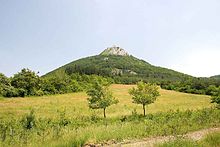Nappe

Ingeology,anappeorthrust sheetis a large sheetlike body ofrockthat has been moved more than 2 km (1.2 mi)[1]or 5 km (3.1 mi)[2][3]above athrust faultfrom its original position. Nappes form incompressional tectonic settingslikecontinental collisionzones or on the overriding plate in activesubductionzones. Nappes form when a mass of rock is forced (or"thrust") over another rock mass, typically on a low angle fault plane. The resulting structure may include large-scale recumbentfolds,shearing along the fault plane,[4]imbricate thrust stacks,fenstersandklippes.
The term stems from the French word fortableclothin allusion to a rumpled tablecloth being pushed across a table.[4]
History
[edit]Nappes or nappe belts are a major feature of theEuropeanAlps,Dinarides,CarpathiansandBalkans.[5][6]Since the 19th century many geologists have uncovered areas with large-scale overthrusts. Some of these were substantiated withpaleontologicalevidence. The concept was developed byMarcel Alexandre Bertrand,who unraveled the complextectonichistory of the Alps and identified the feature asnappe de charriage.He reinterpreted earlier studies byArnold Escher von der LinthandAlbert Heimin theGlarus Alps.[7]His work inSwitzerlandinfluenced Escher andMaurice Lugeon.Several years later, nappe structure was investigated in northwesternScotlandbyCharles Lapworth.Lugeon later transferred the ideas of nappes to theCarpathians.
Structure
[edit]
Nappecan be qualified in a number of ways to indicate various features of a formation. The frontal part in the direction of movement, is calledthe leading edgeof a nappe; numerousfoldsand secondarythrustsandduplexesare common features here and are sometimes calleddigitations.The surface of athrust faultwhich caused movement of a nappe is called adecollement,detachment planeor sole of thrust. Theroot areais an area where the nappe is completely separated from its substratum. It is often compressed and reduced, even underthrust below the surrounding tectonic units, resulting in a specific structure called asuture.A nappe whose root area is unknown, is called arootless nappe.
Areas with a nappe structure often contain two types of geological features:
- Anappe outlierorklippeis a small area isolated from the main body of the nappe byerosionthat lies on the autochthonous base; the summit ofVeľký Rozsutecin theWestern Carpathiansis a typical example, orChief MountaininGlacier National Park,USA.[8]
- Afault inlier,fenster,orwindowis an area of the autochthonous basement uncovered by erosion, but entirely surrounded by the body of the nappe; theHohe Tauern windowin the Alps is a typical example.
Classification
[edit]According to petrographical composition, two basic types of nappes are known:
- Basement nappesare composed generally ofcrystalline basementrocks (but may contain basement sedimentary cover), forming so-calledthick-skinned style.Nappes of this type usually reach a large thickness and form independent superunits such asPenninic nappes.
- Cover nappesor so calledsuperficial nappesare composed generally ofsedimentary rocksthat form the upper part ofcrust,forming so-calledthin-skinned style.Therefore, nappes of this type form smaller units, such as theHallstatt nappein theAustroalpine nappesof the Alps.
Mechanisms of emplacement
[edit]
Nappes are generally considered ascompressionalstructures, however some exceptions could be found especially among the gravitational slides along low angle faults.[9][10]Gravitational forces could even be important in certain cases during emplacement of compressional thrusts. The movement of huge masses of rock may be influenced by several forces, forces that may act together or sequentially. These forces frequently result in high temperature and pressure metamorphism and strong deformation of nappe rocks.[11]
At shallower depths, lowpressuresandtemperaturescan't cause theplasticandviscousbehavior of solidrocknecessary to move along low angle faults. It is considered that such characteristics may be achieved at significantly less extreme conditions in theclayeyrocks orevaporites,which can then act as tectoniclubricants.The process, which significantly reduces thefrictionalresistance, is the fluid overpressure, which acts against the normal pressure, thereby reducing high lithostatic pressures and allowingfracturation,cataclasisand formation oftectonic brecciaorfault gougethat could act as adecollementplane. Evaporites are also often related the decollement and thrust planes. Evaporites are strongly prone toshear deformationand therefore preferred planes of detachment.[12]
Behavior ofthrustsheets is currently explained on the model of theorogenic wedge,which is dependent on the internal wedge taper θ.[13]Gravitational sliding is movement generated by the movement down an inclined plane under the action ofgravity.Gravitational spreading, possibly accompanied by an initial phase ofdiapirism,is generated by large heat flow that causes detachment in ahinterland.[14]Other mechanisms, such as push from behind, action of tangential compressive forces, and shortening of the basement, are essentially variations of the previous mechanisms.
References
[edit]- ^Howell, J.V. (Editor) 1960:Glossary of geology and related sciences.American Geological Institute, Washington D.C., 325 p.
- ^Marko, F., Jacko, S., 1999:Structural geology (General and systematic).Archived2011-07-19 at theWayback MachineISBN80-88896-36-3Vydavateľstvo Harlequin, Košice, p. 81 - 93(in Slovak)
- ^Dennis, J. G., 1967, International tectonic dictionary. AAPG, Tulsa, p. 112
- ^abTwiss, Robert J. and Eldridge M. Moores,Structural Geology,W. H. Freeman, 1992, p. 236ISBN978-0716722526
- ^Schmid, S. M., Fügenschuh, B., Kissling, E, and Schuster, R. 2004:Tectonic Map and Overall Architecture of the Alpine Orogen.Archived2012-01-12 at theWayback MachineEclogae geologicae Helvetiaev. 97, Basel: Birkhäuser Verlag, pp. 93–117, ISSN 0012-9402
- ^Gamkrelidze, I.P. 1991:Tectonic nappes and horizontal layering of the Earth’s crust in the Mediterranean belt (Carpathians, Balkanides and Caucasus).Tectonophysics, 196, p. 385-396
- ^Franks, S., Trümpy, R., 2005:The Sixth International Geological Congress: Zürich, 1894.Episodes, vol. 28, 3, p. 187-192
- ^Nevin, C. M., 1950: Principles of structural geology. 4th ed. John Willey & Sons, London
- ^Graham, R.H. (1979) "Gravity sliding in the Maritime Alps" pp. 335–352InMcClay, K. R. and Price, N.J. (editors) (1981)Thrust and Nappe Tectonics(Geological Society of London Special Publication 9) Blackwell Scientific, Oxford, England,ISBN978-0-632-00614-4
- ^Park, R. G. (2004) [1997].Foundations of Structural Geology(reprint of 1997 edition of Chapman & Hall) (third ed.). Abingdon, England: Taylor and Francis. pp. 131–132.ISBN978-0-7487-5802-9.
- ^Rodrigues, S. W. O., Martins-Ferreira, M. A. C., Faleiros, F. M., Neto, M. D. C. C., & Yogi, M. T. A. G. (2019). Deformation conditions and quartz c-axis fabric development along nappe boundaries: The Andrelândia Nappe System, Southern Brasília Orogen (Brazil). Tectonophysics.
- ^Davis, D.M., Engelder, T., 1985:The role of salt in fold-and-thrust belts.Tectonophysics, 119, p. 67-88
- ^Nemčok, M., Schamel, S., Gayer, R. A., 2005:Thrustbelts: structural architecture, thermal regimes and petroleum systems.Cambridge University Press, Cambridge, 554 p.
- ^Price, N.J., McClay, K.R., 1981:Introduction.p. 1-5 in Price, N.J., McClay, K.R. (Eds.),Thrust and Nappe Tectonics.Geological Society, Special Publications vol. 9, London, 528 p.
